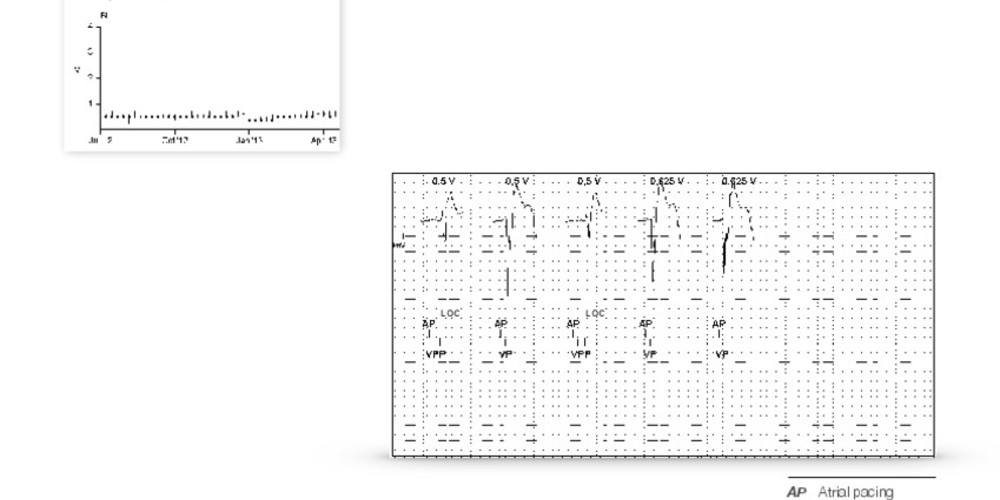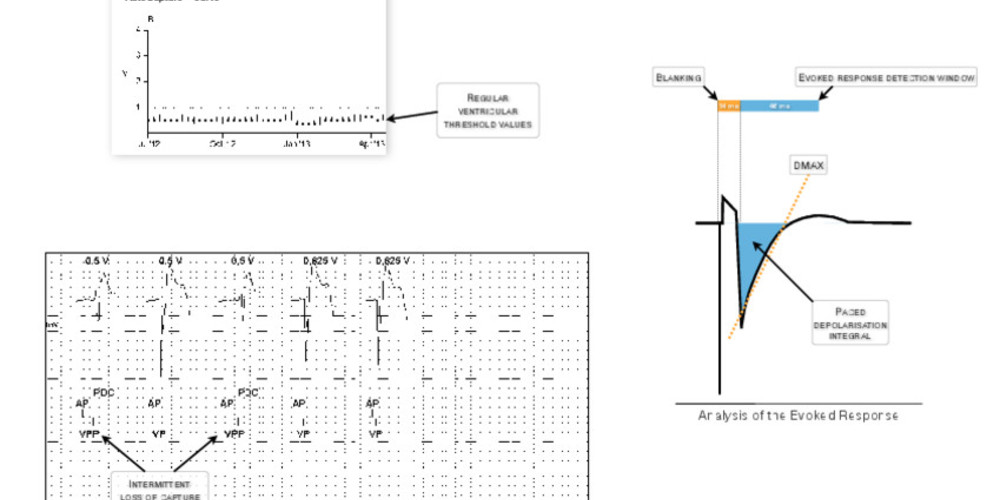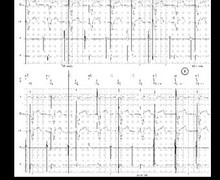ventricular AutoCaptureTM and automatic ventricular threshold measurement
Tracing
Manufacturer Abbott
Device PM
N° 17
Patient
69-year-old man implanted with an AccentTM DR pacemaker for complete atrioventricular block; programming of ventricular AutoCaptureTM; interrogation of the pacemaker and analysis of the monitoring curves of the automatic ventricular threshold measurement.

Graph and trace
The AutoCaptureTM curve shows low (<1 V) and regular ventricular threshold values; the tracing of the last automatic measurement shows an intermittent loss of capture at 0.5 V and an effective capture at 0.625 which therefore constitutes the ventricular threshold value.

Other articles that may be of interest to you





The device uses 4 complementary algorithms for the functioning of ventricular AutoCaptureTM:
1) Capture confirmation which is based as explained previously on an analysis of the Evoked Response; if a ventricular pacing configuration is programmed to bipolar mode, the area under the curve is used (Paced Depolarization Integral); if a ventricular pacing configuration is programmed to unipolar mode, the signal slope (DMAX) is used; to verify the presence of the capture, there is an initial blanking period of 14 ms followed by an evoked response detection window of 46 ms; if the device detects an evoked response in this window, the capture is confirmed; if no evoked response signal is sensed, the device emits a 5 V backup pulse within 80 to 100 ms after the initial pulse to ensure capture;
2) Loss of capture Recovery; if capture verification confirms two consecutive losses of capture, the device launches the loss of capture recovery algorithm; on the ensuing cycle, the pacemaker delivers a backup pulse and then increases the automatic pulse amplitude by 0.25 V and searches for a capture; if no capture is confirmed, the device increases the pulse amplitude by 0.125 V on the next cycle and searches for the capture; when two successive captures are confirmed at the same voltage, the apparatus begins a threshold search; if no capture is confirmed before the device automatically increases the pulse amplitude to 3.875V, the device switches to High output mode: the pulse amplitude is set to 5V and the duration pulse to 0.5 ms (or longer if the programming value is higher); after 128 cycles, the device reinitiates a threshold search;
3) Fusion avoidance: fusions with intrinsic activation can skew threshold measurements with untimely activation of the loss of capture recovery algorithm; in dual-chamber mode, a single absence of evoked response sensing, requiring the delivery of a 5 V backup pulse, automatically causes the next cycle to prolong the paced and sensed AV delay by 100 ms in order to search for intrinsic conduction; in first line treatment, the algorithm « makes the assumption » that the loss of capture is due to a fusion and not to a lack of pulse strength; this function acts in a manner similar to VIPTM; if the loss of capture is confirmed after extending the paced or sensed AV delay (2 consecutive beats requiring the delivery of a 5-V safety pulse), the pacemaker triggers its capture recovery algorithm;
4) Periodic measurement of the pacing threshold: to automatically determine the pacing threshold, the device decreases the pulse amplitude by 0.25 V every two cycles; if this leads to a loss of capture, the device emits a 5 V backup pulse (safety margin) 80 to 100 ms after the first test pulse; in the event of loss of capture over two consecutive cycles at the same amplitude, the algorithm then increases the pulse amplitude in steps of 0.125 V every two cycles; two consecutive captures at the same amplitude must be confirmed to determine the new pacing threshold value; if the decremental search fails to determine a loss of capture at the lowest pulse amplitude setting, i.e. 0 V, the device switches to « High output mode » for a duration of 128 cardiac cycles, then reinitiates the threshold search; if the pacing threshold determined by the algorithm exceeds 3.875 V for a given pulse duration, the ventricular AutoCaptureTM is automatically deactivated and the amplitude is reprogrammed to 5 V (High output mode); the threshold search is repeated a) after each loss of capture recovery operation, b) automatically every 8 hours, c) upon removal of the telemetry head, d) upon removal of the magnet, e) when the operator performs the pacemaker AutocaptureTM threshold test.